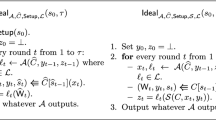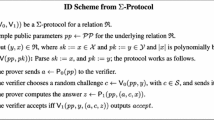Abstract
Tampering attacks are cryptanalytic attacks on the implementation of cryptographic algorithms (e.g., smart cards), where an adversary introduces faults with the hope that the tampered device will reveal secret information. Inspired by the work of Ishai et al. [Eurocrypt’06], we propose a compiler that transforms any circuit into a new circuit with the same functionality, but which is resilient against a well-defined and powerful tampering adversary. More concretely, our transformed circuits remain secure even if the adversary can adaptively tamper with every wire in the circuit as long as the tampering fails with some probability δ > 0. This additional requirement is motivated by practical tampering attacks, where it is often difficult to guarantee the success of a specific attack.
Formally, we show that a q-query tampering attack against the transformed circuit can be “simulated” with only black-box access to the original circuit and log(q) bits of additional auxiliary information. Thus, if the implemented cryptographic scheme is secure against log(q) bits of leakage, then our implementation is tamper-proof in the above sense. Surprisingly, allowing for this small amount of information leakage allows for much more efficient compilers, which moreover do not require randomness during evaluation. Similar to earlier works our compiler requires small, stateless and computation-independent tamper-proof gadgets. Thus, our result can be interpreted as reducing the problem of shielding arbitrary complex computation to protecting simple components.
Access this chapter
Tax calculation will be finalised at checkout
Purchases are for personal use only
Preview
Unable to display preview. Download preview PDF.
Similar content being viewed by others
References
The full version of this paper will be posted on the Cryptology ePrint Archive, http://eprint.iacr.org/
Akavia, A., Goldwasser, S., Vaikuntanathan, V.: Simultaneous hardcore bits and cryptography against memory attacks. In: Reingold, O. (ed.) TCC 2009. LNCS, vol. 5444, pp. 474–495. Springer, Heidelberg (2009)
Alwen, J., Dodis, Y., Wichs, D.: Leakage-resilient public-key cryptography in the bounded-retrieval model. In: Halevi, S. (ed.) CRYPTO 2009. LNCS, vol. 5677, pp. 36–54. Springer, Heidelberg (2009)
Anderson, R., Kuhn, M.: Tamper resistance: a cautionary note. In: WOEC 1996, p. 1. USENIX Association, Berkeley (1996)
Blömer, J., Seifert, J.-P.: Fault based cryptanalysis of the advanced encryption standard (AES). In: Wright, R.N. (ed.) FC 2003. LNCS, vol. 2742, pp. 162–181. Springer, Heidelberg (2003)
Boneh, D., DeMillo, R.A., Lipton, R.J.: On the importance of eliminating errors in cryptographic computations. J. Cryptology 14(2), 101–119 (2001)
Dziembowski, S., Pietrzak, K., Wichs, D.: Non-malleable codes. In: ICS 2010, pp. 434–452 (2010)
Faust, S., Kiltz, E., Pietrzak, K., Rothblum, G.N.: Leakage-resilient signatures. In: Micciancio, D. (ed.) TCC 2010. LNCS, vol. 5978, pp. 343–360. Springer, Heidelberg (2010)
Faust, S., Rabin, T., Reyzin, L., Tromer, E., Vaikuntanathan, V.: Protecting circuits from leakage: the computationally-bounded and noisy cases. In: Gilbert, H. (ed.) EUROCRYPT 2010. LNCS, vol. 6110, pp. 135–156. Springer, Heidelberg (2010)
Gennaro, R., Lysyanskaya, A., Malkin, T., Micali, S., Rabin, T.: Algorithmic tamper-proof (ATP) security: Theoretical foundations for security against hardware tampering. In: Naor, M. (ed.) TCC 2004. LNCS, vol. 2951, pp. 258–277. Springer, Heidelberg (2004)
Goldwasser, S., Rothblum, G.N.: Securing computation against continuous leakage. In: Rabin, T. (ed.) CRYPTO 2010. LNCS, vol. 6223, pp. 59–79. Springer, Heidelberg (2010)
Ishai, Y., Prabhakaran, M., Sahai, A., Wagner, D.: Private circuits II: Keeping secrets in tamperable circuits. In: Vaudenay, S. (ed.) EUROCRYPT 2006. LNCS, vol. 4004, pp. 308–327. Springer, Heidelberg (2006)
Ishai, Y., Sahai, A., Wagner, D.: Private circuits: Securing hardware against probing attacks. In: Boneh, D. (ed.) CRYPTO 2003. LNCS, vol. 2729, pp. 463–481. Springer, Heidelberg (2003)
Juma, A., Vahlis, Y.: Protecting cryptographic keys against continual leakage. In: Rabin, T. (ed.) CRYPTO 2010. LNCS, vol. 6223, pp. 41–58. Springer, Heidelberg (2010)
Katz, J., Vaikuntanathan, V.: Signature schemes with bounded leakage resilience. In: Matsui, M. (ed.) ASIACRYPT 2009. LNCS, vol. 5912, pp. 703–720. Springer, Heidelberg (2009)
Naor, M., Segev, G.: Public-key cryptosystems resilient to key leakage. In: Halevi, S. (ed.) CRYPTO 2009. LNCS, vol. 5677, pp. 18–35. Springer, Heidelberg (2009)
Otto, M.: Fault Attacks and Countermeasures. PhD thesis, University of Paderborn, Germany (2006)
Skorobogatov, S.P., Anderson, R.J.: Optical fault induction attacks. In: Kaliski Jr., B.S., Koç, Ç.K., Paar, C. (eds.) CHES 2002. LNCS, vol. 2523, pp. 2–12. Springer, Heidelberg (2003)
Author information
Authors and Affiliations
Editor information
Editors and Affiliations
Rights and permissions
Copyright information
© 2011 Springer-Verlag Berlin Heidelberg
About this paper
Cite this paper
Faust, S., Pietrzak, K., Venturi, D. (2011). Tamper-Proof Circuits: How to Trade Leakage for Tamper-Resilience. In: Aceto, L., Henzinger, M., Sgall, J. (eds) Automata, Languages and Programming. ICALP 2011. Lecture Notes in Computer Science, vol 6755. Springer, Berlin, Heidelberg. https://doi.org/10.1007/978-3-642-22006-7_33
Download citation
DOI: https://doi.org/10.1007/978-3-642-22006-7_33
Publisher Name: Springer, Berlin, Heidelberg
Print ISBN: 978-3-642-22005-0
Online ISBN: 978-3-642-22006-7
eBook Packages: Computer ScienceComputer Science (R0)




